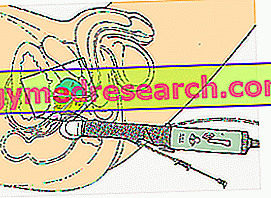Generality
Ultrasound of the prostate is a diagnostic test aimed at the indirect vision of this gland, which enriches the seminal fluid of important components.

By capturing the intensity of the reflected ultrasounds and transforming them into electrical signals first and then into images, the ultrasound probe allows, with the aid of a computer, to reproduce images of the prostate on the appropriate screen. Thus, during a prostatic ultrasound the doctor can investigate the size and morphology of the gland, looking for abnormal lesions or formations.
PLEASE NOTE: For this particular method of execution, we speak of transrectal ultrasound of the prostate . However, there is another type of prostatic ultrasound, performed with a suprapubic technique, which we will not cover in the article.
The suprapubic ultrasound of the prostate is performed with a full bladder, placing the ultrasound probe on the outside of the body in the suprapubic area (approximately halfway between the navel and the base of the penis). However, this technique has some limitations with respect to the previous one, substantially related to the lower precision.
Biopsy
If necessary, after appropriate anesthesia of the surrounding area, it has the possibility of taking small samples of prostate tissue to be examined in the laboratory. This procedure, called prostatic biopsy, is essential to diagnose cancer in the presence of altered values of PSA (prostate specific antigen) and / or suspected abnormal formations after digital rectal exploration.
Applications
Transrectal ultrasound of the prostate therefore allows for:
- evaluate the size and morphology of the gland;
- investigate the causes responsible for high levels of PSA or anomalies in rectal exploration (the urologist introduces his own index in the patient's anus and feels the gland through the intestinal wall);
- place an early diagnosis of prostate cancer thanks to the subsequent microscopic examination of samples taken by biopsy (ultrasound of the prostate, on its own, is not considered a reliable technique to diagnose prostate cancer and must necessarily be accompanied by biopsy); an early diagnosis, in turn, very often translates into a better and more effective therapeutic intervention;
- assess the prostate health status as a "screening test" from the age of 50;
- assess the state of health of the prostate in the presence of suspected symptoms or disorders, such as difficulty in urinating, decreased caliber and urinary jet, frequent urination, infertility;
- monitor the degree of effectiveness of the medical therapy undertaken to resolve any prostate problems. Under ultrasound guidance, some therapies against prostate cancer, such as cryotherapy and brachytherapy, are also performed.
Prostate tests
X Problems with video playback? Reload from YouTube Go to Video Page Go to Wellness Destination Watch the video on youtubeHow do you do it?
During ultrasound of the prostate the patient lies on his left side, with his thighs flexed towards his chest. In all, the procedure takes about ten minutes; before the insertion of the probe the doctor performs a preliminary rectal exploration with his own index to ascertain the absence of contraindications to the examination.
Is it Dolorosa?
The ultrasound of the prostate is not in itself a painful or annoying exam, but it can become so if it is necessary to perform a prostatic biopsy. In this case, very short spells of limited intensity are typically felt during biopsy samples, which are performed under local anesthesia.
In this case the preparation for the exam becomes more complex, as it requires the suspension of a whole series of drugs taken and the use of antibiotics in the days before and for a few days after the examination; the risk of complications is also much greater, generally in any case transient.
Preparation
Fasting is not necessary before undergoing the examination, but it is advisable to perform an enema within 3-4 hours from the appointment in order to empty the rectal ampoule and remove faecal residues from the rectum which could make the examination less easy; alternatively you can use a glycerin suppository the night before and one in the morning. In this regard, however, it is important to follow scrupulously the indications previously provided by the urologist who will perform the prostate ultrasound. Another important recommendation is to carry out the examination with a full bladder, so it is recommended to hold the urine in the hour preceding the ultrasound drinking about a liter of water.



